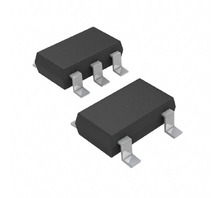Manufacturer Part Number
MIC5265-2.9YD5-TR
Manufacturer
Microchip Technology
Introduction
The MIC5265-2.9YD5-TR is a low-dropout linear voltage regulator designed for power management applications.
Product Features and Performance
Output Configuration: Positive
Output Type: Fixed
Number of Regulators: 1
Maximum Input Voltage: 5.5V
Minimum/Fixed Output Voltage: 2.9V
Maximum Voltage Dropout: 0.5V at 150mA load
Output Current: 150mA
Quiescent Current: 2 µA
Supply Current: 150 µA
Power Supply Rejection Ratio: 64dB to 62dB from 1kHz to 100Hz
Control Features: Enable
Protection Features: Over Temperature, Under Voltage Lockout (UVLO)
Product Advantages
Enhanced stability with fixed 2.9V output
Ultra-low quiescent current beneficial for battery-powered devices
High PSRR ensuring clean output voltage
Robust protection mechanisms safeguarding device under abnormal conditions
Key Technical Parameters
Voltage - Input (Max): 5.5V
Voltage - Output (Min/Fixed): 2.9V
Voltage Dropout (Max): 0.5V @ 150mA
Current - Output: 150mA
Current - Quiescent (Iq): 2 µA
Current - Supply (Max): 150 µA
PSRR: 64dB ~ 62dB (1kHz ~ 100Hz)
Quality and Safety Features
High thermal performance and reliability from -40°C to 125°C
Over Temperature Protection
Under Voltage Lockout (UVLO)
Compatibility
Compatible with multiple applications requiring 2.9V fixed output
Package / Case: SOT-23-5 Thin, TSOT-23-5
Easily integrates with various surface mounted technologies
Application Areas
Suitable for mobile devices, wireless communication equipment, and portable electronics
Product Lifecycle
Status: Active
Continued support and availability within Microchip Technology's product line
Several Key Reasons to Choose This Product
High precision output essential for sensitive applications
Excellent thermal and electrical characteristics ensure reliable operation
Low dropout voltage beneficial in scenarios with low input voltage availability
Minimal power loss and extended battery life due to low quiescent current
Strong protection features add an extra layer of security against operational anomalies



 MIC5265-2.5YD5TRMicrel / Microchip Technology
MIC5265-2.5YD5TRMicrel / Microchip Technology